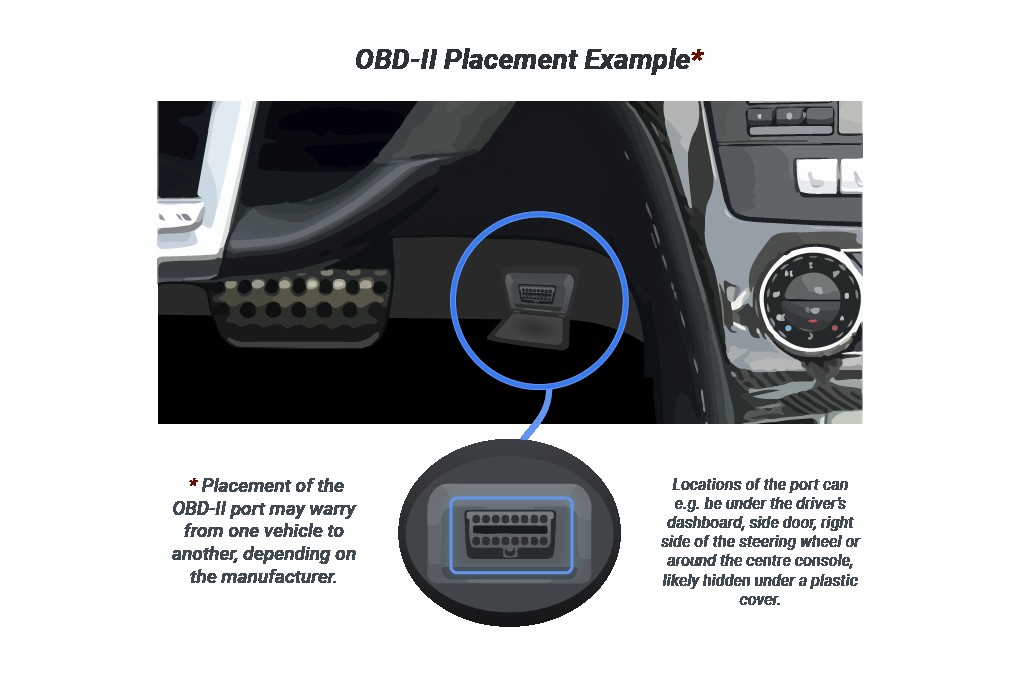The OBD2 port, short for On-Board Diagnostics, is a crucial component in modern vehicles. It acts as a communication portal, providing access to a wealth of data about your car’s performance and health. This article serves as your comprehensive guide to understanding the OBD2 port, its location, and how an “Obd2 Locator” can be helpful. We’ll delve into the specifics of the port itself, its functionality, and why knowing its location is essential for every car owner.
Where is My OBD2 Port? Using an OBD2 Locator
Most vehicles manufactured after 1996 have a standardized OBD2 port. It’s typically located within the driver’s reach, often under the dashboard on the driver’s side. However, the exact position can vary depending on the make and model of your car.
Common OBD2 port locations include:
- Under the steering wheel: This is the most common location. Look for a trapezoidal connector typically within two feet of the steering column.
- Above the pedals: Sometimes, the port is situated above the foot pedals, requiring you to bend down to locate it.
- Behind the ashtray or cigarette lighter: In some vehicles, the OBD2 port might be hidden behind a removable panel near the ashtray or cigarette lighter.
- Inside the center console: Less frequently, the port can be found inside the center console storage compartment.
- Inside the glove box: Occasionally, manufacturers place the OBD2 port inside the glove compartment.
If you’re struggling to find your OBD2 port, an “obd2 locator” can be incredibly helpful. This can refer to:
- Your vehicle’s owner’s manual: The manual should provide specific instructions and diagrams indicating the OBD2 port location for your car model.
- Online OBD2 port locator tools: Websites and apps specialize in helping you pinpoint the OBD2 port based on your car’s year, make, and model. Simply enter your vehicle information, and the tool will display the likely location.
Understanding the OBD2 Connector
The OBD2 connector is a standardized 16-pin (2×8) female connector, often referred to as the J1962 connector. Diagnostic tools and devices connect to this port to access vehicle data.
OBD2 Pinout: Deciphering the Pins
Each of the 16 pins on the OBD2 connector has a specific function, often related to communication protocols or power supply.
- Grounding (Pins 4 and 5): Provide essential grounding for stable data transmission.
- J1850 BUS+ (Pins 2 and 10): Used for communication with specific vehicle systems, particularly in older models.
- CAN Bus (Pins 6 and 14): The Controller Area Network (CAN) bus is a crucial communication network in modern vehicles, enabling various modules to exchange data.
Why is the OBD2 Port Important?
The OBD2 port is vital for:
- Diagnostics: Mechanics and car owners can use OBD2 scanners to read diagnostic trouble codes (DTCs), which indicate malfunctions within the vehicle’s systems.
- Emissions Testing: Emissions systems are monitored through the OBD2 port to ensure compliance with environmental regulations.
- Vehicle Monitoring: Devices connected to the OBD2 port can track various parameters such as speed, fuel consumption, and engine performance.
Unlocking Advanced Diagnostics
While basic OBD2 scanners provide valuable information, advanced tools like the AutoPi CAN-FD Pro offer more in-depth insights into your vehicle’s performance. These tools leverage the OBD2 port for comprehensive data logging and analysis.
Conclusion: Mastering Your Vehicle’s Data with the OBD2 Port
The OBD2 port is a powerful tool for understanding and maintaining your vehicle. Whether you’re troubleshooting a warning light, monitoring performance, or seeking in-depth diagnostics, knowing how to locate and utilize your OBD2 port is essential for every car owner. By utilizing resources like online “obd2 locator” tools and your owner’s manual, you can quickly find your OBD2 port and unlock valuable insights into your car’s health. This knowledge empowers you to take control of your vehicle’s maintenance and ensure optimal performance.

